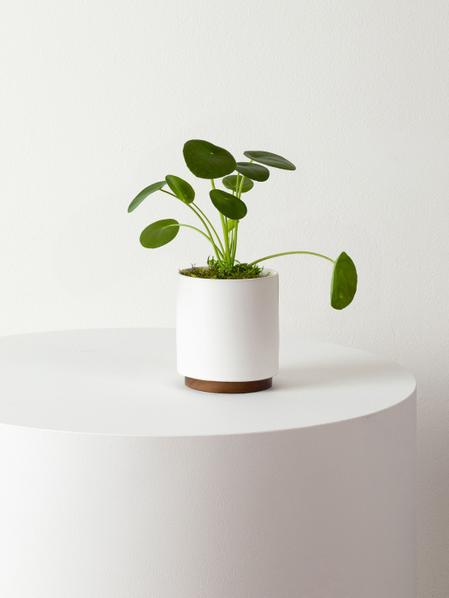
Questions about the Pilea Peperomioides 8 in tall Small Mid-Century Ceramic
An adorably quirky plant that only recently started appearing on the shelves of retail shops, the Pilea Peperomiodes or Chinese Money Plant is known for its unique, coin-like foliage and ease of propagation, thus earning itself the nickname of “the friendship plant.”
Note: this plant is highly susceptible to extreme temperatures. It is carefully wrapped and protected for transit, though may arrive with a few unhappy stems which can be safely trimmed. An incredibly hardy and fast growing plant, new growth may begin to appear in as little as just a few weeks.
How Fast Do Pileas (Chinese Money Plants) Grow?
The Pilea—commonly known as the Chinese Money Plant—is a fast-growing, easy-to-care-for houseplant. When provided with bright, indirect light, consistent watering, and warm temperatures, Pilea will quickly produce new round, coin-shaped leaves and often sends out pups (small offshoots) that can be propagated to grow new plants.
During the active growing season, typically spring through early fall, you can expect noticeable growth with new leaves emerging every few weeks. Growth slows during the winter months when the plant enters a period of dormancy.
With the right care, Pilea can grow from a small tabletop plant to a bushier specimen in under a year, making it a popular choice for beginners and plant enthusiasts alike.
How Do I Water My Pilea?
Proper watering is essential to keep your Pilea (Chinese Money Plant) thriving. Water the plant when the top inch of soil feels dry to the touch. Pilea prefers soil that is lightly moist but well-draining, so it’s important to avoid overwatering, which can lead to root rot.
Generally, watering every 7 to 10 days works well, but this can vary depending on the season and indoor humidity. During warmer months, you might need to water more frequently, while in winter, watering should be reduced.
When watering, thoroughly soak the soil and allow excess water to drain out of the pot’s bottom. Be sure to empty any standing water from saucers or trays to prevent soggy roots.
Signs of underwatering include drooping or curling leaves, while overwatering often causes yellowing leaves and mushy stems. Maintaining a consistent watering routine helps your Pilea stay healthy and vibrant.